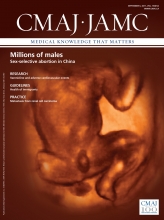Research
Radial nerve palsy in the newborn: a case series
Fatema S. Alsubhi, Abdullah M. Althunyan, Christine G. Curtis and Howard M. Clarke
CMAJ September 06, 2011 183 (12) 1367-1370; DOI: https://doi.org/10.1503/cmaj.110272
Fatema S. Alsubhi
Abdullah M. Althunyan
Christine G. Curtis
Howard M. Clarke
In this issue
Article tools
Respond to this article
Radial nerve palsy in the newborn: a case series
Fatema S. Alsubhi, Abdullah M. Althunyan, Christine G. Curtis, Howard M. Clarke
CMAJ Sep 2011, 183 (12) 1367-1370; DOI: 10.1503/cmaj.110272











